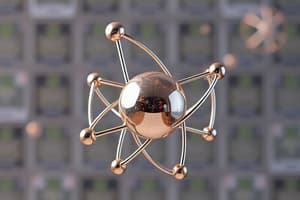Podcast
Questions and Answers
What is the smallest unit of a chemical element that retains the properties of that element?
What is the smallest unit of a chemical element that retains the properties of that element?
- Electron
- Atom (correct)
- Neutron
- Proton
Which particles have a positive charge and reside in the nucleus of the atom?
Which particles have a positive charge and reside in the nucleus of the atom?
- Isotopes
- Neutrons
- Protons (correct)
- Electrons
What determines the element of an atom?
What determines the element of an atom?
- Number of protons (correct)
- Number of electrons
- Mass of the atom
- Number of neutrons
What is the charge of neutrons?
What is the charge of neutrons?
What is the outermost energy level of an atom called?
What is the outermost energy level of an atom called?
Which model proposes that electrons occupy specific energy levels around the nucleus?
Which model proposes that electrons occupy specific energy levels around the nucleus?
What is the maximum number of electrons that the first shell can hold?
What is the maximum number of electrons that the first shell can hold?
What is the term for atoms of the same element with different numbers of neutrons?
What is the term for atoms of the same element with different numbers of neutrons?
What is the mass of electrons compared to protons and neutrons?
What is the mass of electrons compared to protons and neutrons?
What is the purpose of the valence shell in an atom?
What is the purpose of the valence shell in an atom?
Flashcards are hidden until you start studying
Study Notes
Atomic Structure Overview
- An atom is the smallest unit of a chemical element that retains the properties of that element.
- Atoms are composed of three main parts: protons, neutrons, and electrons.
Protons
- Protons are positively charged particles that reside in the nucleus (center) of the atom.
- The number of protons in an atom determines the element of an atom, and each element has a unique number of protons in its atoms.
- Protons have a positive charge and a mass of approximately 1 atomic mass unit (amu).
Neutrons
- Neutrons are particles that reside in the nucleus along with protons.
- Neutrons have no charge and a mass of approximately 1 amu.
- The number of neutrons in an atom can vary, leading to different isotopes (atoms of the same element with different numbers of neutrons) of an element.
Electrons
- Electrons are negatively charged particles that orbit the nucleus of the atom.
- Electrons have a negative charge and a very small mass compared to protons and neutrons.
- The number of electrons in an atom is equal to the number of protons, and this number determines the chemical properties of an element.
- Electrons are arranged in energy levels or shells around the nucleus.
Electron Shells
- The closest shell to the nucleus is the first shell, which can hold up to 2 electrons.
- The second shell can hold up to 8 electrons, and the third shell can hold up to 18 electrons.
- The outermost energy level is called the valence shell, and it is involved in chemical bonding.
Atomic Models
- The Rutherford model: proposes that the nucleus is surrounded by electrons orbiting at a distance.
- The Bohr model: proposes that electrons occupy specific energy levels around the nucleus, and that electrons jump from one energy level to another by emitting or absorbing energy.
- The Quantum Mechanical model: a more modern and accurate model that describes the behavior of electrons in terms of probability distributions and wave functions.
Atomic Structure Overview
- An atom is the smallest unit of a chemical element that retains the properties of that element.
Protons
- Protons are positively charged particles that reside in the nucleus (center) of the atom.
- The number of protons in an atom determines the element of an atom, and each element has a unique number of protons in its atoms.
- Protons have a positive charge and a mass of approximately 1 atomic mass unit (amu).
Neutrons
- Neutrons are particles that reside in the nucleus along with protons.
- Neutrons have no charge and a mass of approximately 1 amu.
- The number of neutrons in an atom can vary, leading to different isotopes (atoms of the same element with different numbers of neutrons) of an element.
Electrons
- Electrons are negatively charged particles that orbit the nucleus of the atom.
- Electrons have a negative charge and a very small mass compared to protons and neutrons.
- The number of electrons in an atom is equal to the number of protons, and this number determines the chemical properties of an element.
- Electrons are arranged in energy levels or shells around the nucleus.
Electron Shells
- The closest shell to the nucleus is the first shell, which can hold up to 2 electrons.
- The second shell can hold up to 8 electrons, and the third shell can hold up to 18 electrons.
- The outermost energy level is called the valence shell, and it is involved in chemical bonding.
Atomic Models
- The Rutherford model proposes that the nucleus is surrounded by electrons orbiting at a distance.
- The Bohr model proposes that electrons occupy specific energy levels around the nucleus, and that electrons jump from one energy level to another by emitting or absorbing energy.
- The Quantum Mechanical model describes the behavior of electrons in terms of probability distributions and wave functions.
Studying That Suits You
Use AI to generate personalized quizzes and flashcards to suit your learning preferences.



